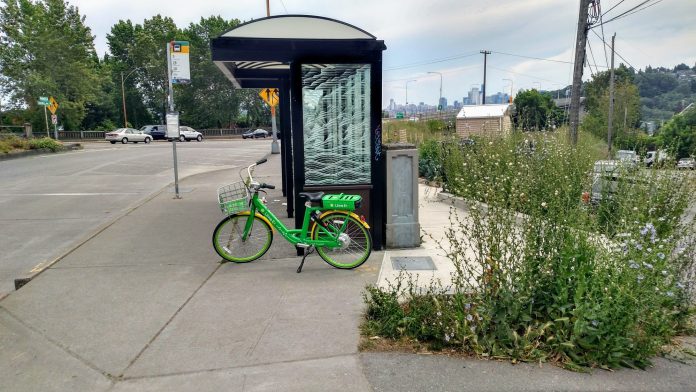A few weeks ago, a group opposed to adding bike lanes to a North Seattle arterial tweeted out, “Single mothers don’t commute to work on bikes. Privileged #techbros do…” Of course, they got pummeled by hundreds of single moms (and dads) who do indeed bike to work every day. But, besides misjudging who actually uses bikes, this (mis)statement captures an often used rejoinder against adding bike lanes to city streets–that only the most able-bodied people cycle frequently enough to have an effect on commuting and thus infrastructure needs.
Lime Bikes (the bike sharing company with the eponymously named green bikes) has recently dropped approximately 1,800 electric-assist bikes all over Seattle (and thousands more around cities throughout the United States). Coming up, the Uber-owned Jump Bikes (another loaner company) will be following suit (about August in Seattle, while they’re already in San Francisco, Washington, D.C., Santa Cruz and Sacramento). These electric-assist bikes are boosted by an electric motor, making them easier to pedal and with a maximum speed of 14 to 20 mph, competitive against more experienced riders and fast enough for roads. The electric motor also takes care of another issue people have against bikes–that places like Seattle and San Francisco are too hilly for riding.
So, will these new e-bikes get more riders out on to urban streets? And if they do, how will that effect infrastructure decisions?
Bike sharing is already quite the success in Seattle. After the ill-fated Pronto dock-based bike share program failed, the city took a measured approach to trying bike sharing again, this time with dockless options. They gave permits to three companies–Lime, Spin, and Ofo–and let them launch with only 500 bikes in the first month. They were then allowed to add 500 more and then, 1,000 more after two months (with the city’s permission for each phase). To start the trial though, the companies had to agree to share all the data they were collecting so the city could find out where people were riding, how many people were using the service, what they were using it for, and more.
To start, riders download an app to locate bikes and then scan a QR code on the bicycle to unlock it. When they’re done, they just relock the bike and walk away. It’s a remarkably efficient system and it’s been overwhelmingly successful. There are 10,000 bikes available and more than 350,000 riders have gone one million miles in just five months. Another interesting fact, three-quarters of all riders have used bikeshare to connect to public transportation–the bikes are getting people to buses and trains.
But while bike sharing is improving mobility, it does have its detractors. People call the bikes “litter” and vandals have taken to throwing them in lakes or tearing them apart and leaving them strewn across parking lots. As with anything, there are those riders who don’t follow the rules and leave bikes where they shouldn’t be, and the bike companies have not implemented a system to punish misusers. There are solutions to all these problems, and right now, most of them are being considered in one way, shape or form by the city council.
Before Lime debuted their e-bikes, electric-assist bikes were already gaining in popularity in Seattle. Seattle E-Bike, Rad Power Bikes, and others sell direct-to-consumer e-bikes, including cargo e-bikes that can accommodate a small family or work well for small deliveries (the University of Washington uses them for mail). The e-bike manufacturers say their primarily demographic is older riders, mainly baby boomers with mobility issues. According to Marty Pluth, general manager at Gregg’s Cycles, e-bikes are the fastest growing segment of their business – doubling in sales each of the last three years.
The reason for this is because, as one cyclist put it, e-bikes “flatten the city”–they remove the part about cycling that so many people dislike, the actual physical labor. Recently, I jumped on a Lime e-bike for a ride home from work–about eight miles. There’s a noticeable boost once you start pedaling and it made hills far easier to climb. But, you still have to pedal and you’re still exerting yourself to get up inclines. I found myself less likely to avoid hills as I would on a regular Lime or Spin or Ofo, but still needing to put some work in.
For me, as someone who cycles frequently to work, I choose this mode of transportation because I want some ‘joyful movement’ as part of my day. If I’m just trying to get to a meeting or zip to public transportation or run a quick errand, I’d take an e-bike over a normal bike any day. Lime and Jump are betting there’s a lot of people like me out there, and they’re probably right. Seattle notoriously has some of the worst traffic in the country and it’s only going to get worse as we continue our unprecedented growth. Couple that with the fact that millennials are (smartly) not embracing cars and are changing the composition of cities by demanding their workplaces are in urban centers (Amazon over Microsoft’s model for instance).
Cities like Seattle are recognizing as well that they cannot build out of their growth–they have to find ways of moving millions of people in, out and around the city that doesn’t involve single occupancy vehicles. Street improvements are combining cycle lanes, HOV lanes, bus-only lanes and other ideas. But, not everyone can or wants to cycle. E-bikes, with their boost and their convenience, could be the big gamechanger we’ve all been waiting for–but they need a chance. We need to revise how we see cycling. Just like the group in North Seattle who tweeted out that only a select few cycle–we need to recognize that people from all walks of life use bicycles to commute, and that even more will jump on board if we build them more facilities and offer them more options. E-bikes represent a true possibility of getting more people out of their cars, and introducing them to the joy of cycling. E-bikes could significantly change commuting for a lot more people for the better–that by itself should be lauded.

Chris Priest
Chris Priest is a writer and community advocate who lives in northeast Seattle. Chris is a founding member of Safe 35th--a community-based group focused on bringing planned and agreed upon safety improvements to 35th Avenue NE in the Wedgwood, Ravenna and Bryant neighborhoods. He is a frequent cyclist, runner, transit rider, and walker who believes safe, inclusive modes of transportation are the way of the future.

